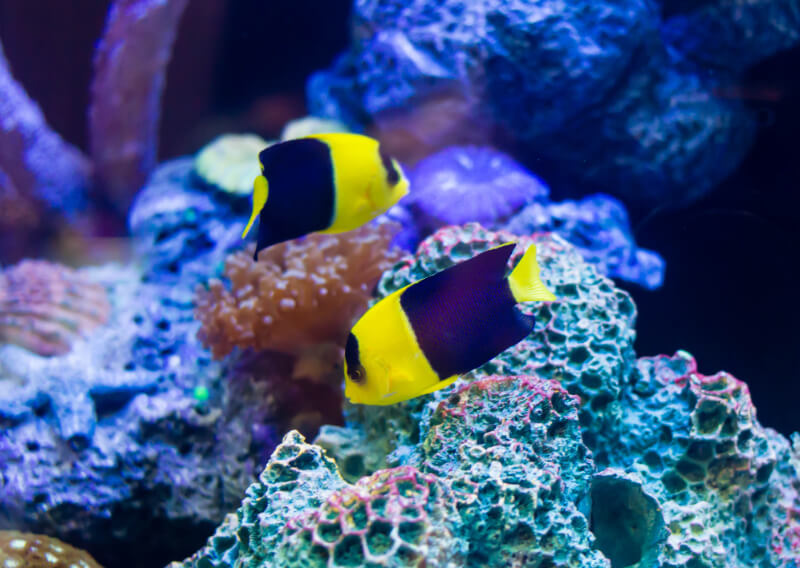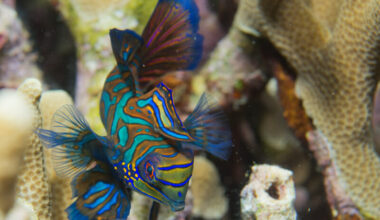Hey there, are you ready to dive into the vibrant world of Bicolor Angels? These captivating fish are absolute stunners with their striking colors and graceful movements. Their brilliant orange-gold body contrasted with a bold black posterior offers a splash of sunshine swimming around your tank!
There are a few important points to keep in mind since they can be a bit aggressive so let’s get started!
Table of Contents
Species Summary
Known as one of the most recognizable dwarf angelfish, the Bicolor Angel originates from the Indo-Pacific region. It’s most often found in the lush reefs around Fiji, New Caledonia, Japan and Papua New Guinea.
Their ideal habitats range from three to 80 feet deep, with the juveniles usually staying closer to the surface. The Centropyge bicolor is also called the Oriole Angelfish or the Two-Colored Angelfish.
While they can be seen in the wild in pairs or small groups, these fish are best limited to one per tank. They’re moderately hardy and may need extra care during the acclimation process. Bicolor Angels are long-lived, active swimmers with big appetites and even bigger personalities.
Author Note: These fish have intermediate care needs and sometimes show aggressive tendencies which could make it difficult to safely introduce them to your aquarium.
Appearance
Bicolor Angels have a bright yellow front half that contrasts beautifully with their deep blue back half. If you look closely, you’ll spot a splash of blue over their eyes. The pectoral and tail fins are yellow while the anal and dorsal fins are blue.

Lifespan
In the wild, these Bicolor Angels typically have a lifespan of about 5 to 10 years while in captivity it can be up to 12 years. Please keep in mind this lifespan is based on a great environment with excellent water conditions and friendly tank mates.
Average Size
Centropyge bicolor are one of the larger dwarf angelfish species. A bicolor angel can grow to an average size of 6-inches.
Bicolor Angel Care
In recent history, it was a challenge to keep these stunning fish alive past their acclimation period due to controversial cyanide fishing techniques. Today, with catching improvements, it’s become easier to keep them happy and healthy. Best suited to at least intermediate aquarists, Bicolor Angelfish will thrive in bigger tanks with high water quality.
Tank Size
For one Bicolor Angelfish, the recommended tank size is at least 55 gallons. Opting for too small of an aquarium will worsen their aggressive tendencies and make them more volatile. Mated angelfish do well in 75-gallon aquariums (check our 75 gallon fish tank guide). If you own two or more unsexed Bicolor Angels, you need an even bigger tank between 100 to 150 gallons. You should never put this fish in a nano tank, not even as a juvenile.
Water Parameters
Water temperature: 72°F to 80°F
pH levels: 8.0 to 8.4
Water hardness: 8 to 12 dKH
Specific gravity: 1.023 to 1.025
Tank Setup
It’s better to choose a longer tank than a taller tank, so your Bicolor Angel has plenty of room along the bottom for exploration. Provide several live rock options where they can hide and search for algae. They require several natural algae sources to supplement their diets.
Author Note: You’re welcome to choose a sandy substrate or something more rugged. Many Bicolor Angelfish appreciate a small rocky area where they can forage and dig around. As for water movement, make sure there’s a weak current along the bottom to help with feeding.
Lighting
Your tank’s lighting should be strong enough to support healthy algae growth. If you use low-lighting options, put your tank in an area of your home that receives direct sunlight during the day.
Filtration
Standard aquarium filtration works great for Bicolor Angels. These fish need a set water quality with minimal fluctuations in pH and hardness. All angelfish will experience a quick health deterioration if left in waters with a pH below 8.
Acclimation
Your tank will need to be at least six months old before you can consider adding one of these fish. While you may want to try the popular floating bag method, Bicolor Angels are better suited to the slower drip acclimation technique. Place your new bagged tank addition in a bucket and run a tube down from your aquarium.
You can use standard tubing or an air pump and siphon to better moderate dripping speed. If you’re struggling to regulate the dripping, feel free to use vice grips.
Author Note: Saltwater invertebrates benefit from two to three hours of this acclimation process. It’s vital to take your time so they’re not shocked by the difference in the specific gravity and pH.
Is the Bicolor Angel Reef Safe?
Unfortunately, the Bicolor Angel is not reef safe. They tend to nip at LPS corals, clams, soft corals, sponges, worms and zoanthids. These angelfish usually leave ornamental crustaceans alone, but they can wreak havoc on the rest of your thriving reef aquarium. If you don’t have a fish-only live rock tank, your best chance is to train good habits into a juvenile.
Common Possible Diseases & Prevention
The Centropyge bicolor, along with other dwarf angelfish, are prone to saltwater diseases like marine ich, marine velvet and bacterial infections as explained below.
- Marine ich or white spot disease, manifests as constant scratching behaviors as well as small white dots on the fins and scales.
- Marine velvet will cause respiratory distress, potential weight loss and yellow or light brown dust on the body.
- Bacterial infections often result from these parasitic diseases, causing dropsy, red streaks or popeye.
To address a parasitic issue, you must raise the temperature of your tank and provide medicated food. Treating these issues can be particularly hard as the copper and chemical solutions are often harmful to the fish.
Author Note: The best way to prevent these issues is to utilize a quarantine tank for all new additions and limit your aquarium’s population.
Food & Diet
Though they’re technically omnivorous, Bicolor Angels prefer a meaty diet since they eat more of these foods than other angelfish. Less than a third of their daily nutrition comes with algae. They much prefer blackworms, brine shrimp and mysid shrimp. Try to feed them foods that have been enriched with spirulina, which is a type of blue-green algae.
They should generally be fed about two to three times a day. Frequent meal times can keep them from nipping at your sessile invertebrates. In a larger tank with an abundance of algae sources, you may only need one or two daily feedings.
In some cases, your new angelfish may refuse to eat frozen food or pellets due to stress. It can be helpful to increase the algae in your tank to get them used to an aquarium environment. Juvenile Bicolor Angels are more agreeable toward a larger variety of foods.
Behavior & Temperament
These beautiful angelfish won’t stray far from the bottom of the tank. They’re incredibly active during the day and can enjoy hiding and searching the live rock. Bicolor Angels have a reputation for being one of the most aggressive dwarf angelfish species, which can make it difficult to keep them in crowded tanks. Adding your angelfish last ensures the rest of your fish have already established their territories.
Bicolor Angelfish Tank Mates & Predators
You don’t want to keep any small, peaceful fish like gobies, fairy wrasses or dartfish with your Bicolor Angel. They may even begin harassing your passive clownfish or anthias if the tank is too small. As for slow movers like seahorses or mandarins, they’ll eat up their food faster, which could lead to starvation concerns.
The best tank mates for these angelfish are large semi-aggressive or aggressive fish. You can even opt for predatory fish as long as you ensure they’re not big enough to eat your Bicolor Angel.
A few of the best tank mates for these gorgeous fish include:
- Dottybacks
- Tangs like the Doctorfish, Kole, Gem and Sohal tangs
- Large Wrasses (the Red Coris Wrasse could reach 12 inches in size)
- Damselfish
- Large Angelfish (try a 15in long Emperor Angelfish)

Breeding
Bicolor Angels are protogynous, meaning the males and females can reverse their sexual orientations within about 20 days. During their courtship period, you can identify the male by the dark line that forms under his eye. One dominant male will often try to mate with several females. Currently, this species has yet to be successfully bred in captivity.
It’s known that they reach sexual maturity once they’re around 2.4 to 2.7 inches long. The spawning process for angelfish usually includes the pair circling each other while the male makes grunting sounds. He will then float up from the substrate and tilt his body to attract the female’s attention.
If she’s interested and ready to reproduce, they will move upwards together and create fertilized eggs. These eggs are left entirely alone and don’t receive any protection from their parents. After a short time, the male will move on to find another female.
Author Note: The angelfish larvae are often hard to raise in captivity due to their very small mouths. After hatching, they’ll float to the top to eat microscopic plankton, which puts them at risk of becoming another fish’s prey.
In Conclusion
Well, folks, we’ve come to the end of our Bicolor Angel care guide. We hope you enjoyed reading it as much as we enjoyed doing the research and putting everything together. Besides taking care of all the basics (food, mates, etc), don’t forget to provide your angelfish with plenty of hiding spots and stimulating environments to keep their curious minds satisfied.
With their dazzling appearance and inquisitive personalities, Bicolor Angels are a truly captivating addition to any saltwater aquarium. If you are looking to learn about other fish try our Saltwater Fish Care Guides and don’t forget to tag us on Facebook when sharing a cool photo of your aquarium!

